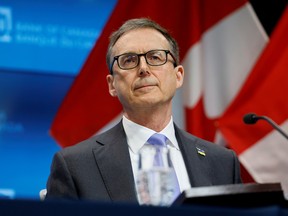Tiff Macklem’s not wrong when he says the central bank got a lot of things right

Article content
What if the Bank of Canada knows what it’s doing?
Advertisement 2
Article content
Inflation is hovering around seven per cent, and the central bank’s target is two per cent, so the easy answer is, “No, it doesn’t have a clue what it’s doing.”
Article content
The news this week that the Bank of Canada lost money for the first time in its 87-year history only adds to the superficial notion that appointing Tiff Macklem to guide monetary policy was a mistake, even if the losses were incurred fighting a crisis that was unlike anything any living policymaker had ever seen.
Article content
“We didn’t get everything right,” Macklem told the House finance committee on Nov. 23. “We got a lot of things right. We have some lessons to learn.”
The inflation miss was a serious mistake that warrants deeper scrutiny in case there are things that can be learned that will keep it from happening again. Macklem told lawmakers that as soon as inflation is back to target, “we are going to have to have a thorough review of how all our tools worked” through the COVID crisis.
Advertisement 3
Article content
When the Bank of Canada gets around to that review, it will turn up positives that are obvious to anyone who bothers to look, but end up obscured by the panic over inflation. The latest evidence that the Bank of Canada hasn’t wrecked the economy arrived Dec. 2, when Statistics Canada reported that hiring was little changed in November, and the jobless rate dropped to 5.1 per cent, a possible sign that higher interest rates might be taking the steam out of the economy without severely hurting momentum.

The dollar fell against the U.S. currency after the numbers were released, so some traders saw the news as a negative that would cause the Bank of Canada to balk at additional interest-rate increases. It’s possible. Macklem was clear at the finance committee that he isn’t finished, but Bay Street and Wall Street are split on whether that means more outsized interest-rate increases, or whether the Bank of Canada might be ready to taper its aggression, given its own forecasts show the economy could easily slide into a recession at any point over the next few months.
Advertisement 4
Article content
Statistics Canada said employers added 10,000 positions last month, less than the survey’s margin of error, making it difficult to say more than the labour market stood still. However, the agency’s monthly survey of households turned up 108,000 positions in October, an unusually large number, so hiring flatlined at a high level in November.
The jobless rate remains well inside any conventional definition of full employment, which is how economists describe an economy in which there are quantitatively enough jobs for everyone who wants one. Full-time employment increased by about 51,000 positions in November, and have increased by some 460,000 positions since November 2021, another sign of a strong labour market.
Advertisement 5
Article content
“It’s quite clear that the labour market remains tight and in solid shape overall,” Douglas Porter, chief economist at Bank of Montreal, said in a note to his clients.
Average hourly wages increased 5.6 per cent from November 2021, the sixth consecutive month that pay gains topped five per cent, a sign of upward inflationary pressure that the Bank of Canada has said it will be watching closely. Porter said the “still firm” pace of pay increases could leave Macklem uneasy about inflation heading into next week’s interest-rate decision, and re-upped his prediction that policymakers will opt to raise the benchmark rate another half point, which would put the target at 4.25 per cent.
-

Bank of Canada could deliver another half-point hike next week
-

Kevin Carmichael: Economy grows faster than expected, raising odds of another big rate hike
Advertisement 6
Article content
The Bank of Canada’s benchmark rate was 0.25 per cent in March, and the possibility of an increase of four percentage points in less than a year will startle those who worried that a decade of ultra-low interest rates would make households and executives supersensitive to higher borrowing costs.
That worry could still be valid. Indeed, after getting beaten up earlier in the year for letting inflation get out of control, the Bank of Canada now regularly faces invective for causing a recession that hasn’t yet happened.
Earlier this week, Statistics Canada reported that gross domestic product grew at an annual rate of 2.9 per cent in the third quarter, much faster than most forecasts. The GDP numbers, paired with the ongoing strength of the labour market, supports Macklem’s bet that it is better to attack inflation now, when the economy is strong, rather than proceed tentatively, discover inflation is persistent, and end up having to raise interest rates when the economy is weaker. It might even be time to resume talking about a “soft landing,” which is how Bay Street talks about the possibility that an inflationary economy can be slowed without crashing into a bad recession.
Advertisement 7
Article content
“We’re entering 2023 at least in better shape than we have seen in many other moments in the past where we’re entering a slowdown or a recession,” Guy Cormier, chief executive of Desjardins Group, told the Financial Post’s Barbara Shecter this week, observing that there is “still money” in the personal and business accounts of the financial institution’s clients. “Yes, there will be a slowdown, but we feel that there are some positive conditions that could unfold in the next six, seven months.”
Here’s another positive: Statistics Canada reported that the employment rate of women aged 25 to 54 rose to 81.6 per cent in November, a record that further narrowed the gap with men. One of the goals of the Bank of Canada’s assault on the COVID crisis was to keep traditionally marginalized groups from getting left behind, betting that would create the foundation for a sturdier recovery.
Macklem’s not wrong when he ways the central bank got a lot of things right.
• Email: kcarmichael@postmedia.com | Twitter: carmichaelkevin


